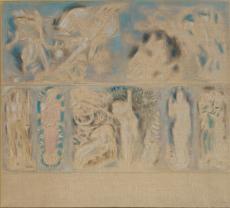


Born in Alexandria, Konstantinos Parthenis, who left an indelible mark on 20th-century Greek art, received his first painting lessons in Egypt, before studying in Vienna (1897-1903). He later lived in Paris (1909-1911) and then moved to Greece, where he joined the ‘Techni’ group of artists (founded in 1917) and became professor at the Athens School of Fine Arts (1929-1947). Historical, mythological, religious and allegorical themes, as well as landscapes, portraits and still-life paintings are his main subjects. Going beyond conservative academic models and introducing types from classical and Byzantine art, Impressionism and Post-Impressionism, Symbolism and Jugendstil, he shaped, through his vision of an ideal Greece and the quest for a national identity, a purely personal idiom exemplified by idealism, purity and spirituality.In his Mythology and Religion, the figures, frontal and linear, are arranged in two parallel bands, with minimal use of colour on a canvas that remains largely uncovered. This allegorical composition dates from Parthenis’ final creative period.
After his first painting lessons in Egypt, under the German Karl Wilhelm Diefenbach, he went to Vienna, where he studied at the RoyalAcademy of Fine Arts (1897-1903) and at the Conservatory. In 1903 he visited Greece for the first time. From 1909 to 1911 he lived in Paris andlater on Corfu, where he became a member of the ‘Group of Nine’. He acquired Greek citizenship and settled in Greece, becoming a memberof the ‘Techni’ group of artists (1917). He held a retrospective exhibition at the Zappeion Hall and received the Greek National Award forExcellence in the Arts and Letters (1920); he also garnered a gold medal at the Exposition Universelle in Paris (1937). In the following year heheld a retrospective at the Venice Biennale. After an unsuccessful attempt in 1923 at the post, in 1929 he became a professor at the Schoolof Fine Arts; he resigned in 1947 and became reclusive in his home. In his absence, he was awarded the Commander of King George I (1954)and the Gold Commander of the Phoenix (1965). One of the founding fathers of 20th-century Greek painting and the teacher of many younger artists, he shaped, through the vision ofan ideal Greece and the demand to determine a national identity, a purely personal idiom, marked by purity and spirituality. Historical,mythological, allegorical and religious themes, alongside landscapes, portraits and still-life paintings, make up the body of his work, inwhich he used types of ancient and Byzantine art, Impressionism and Post-Impressionism, Symbolism and Jugendstil.